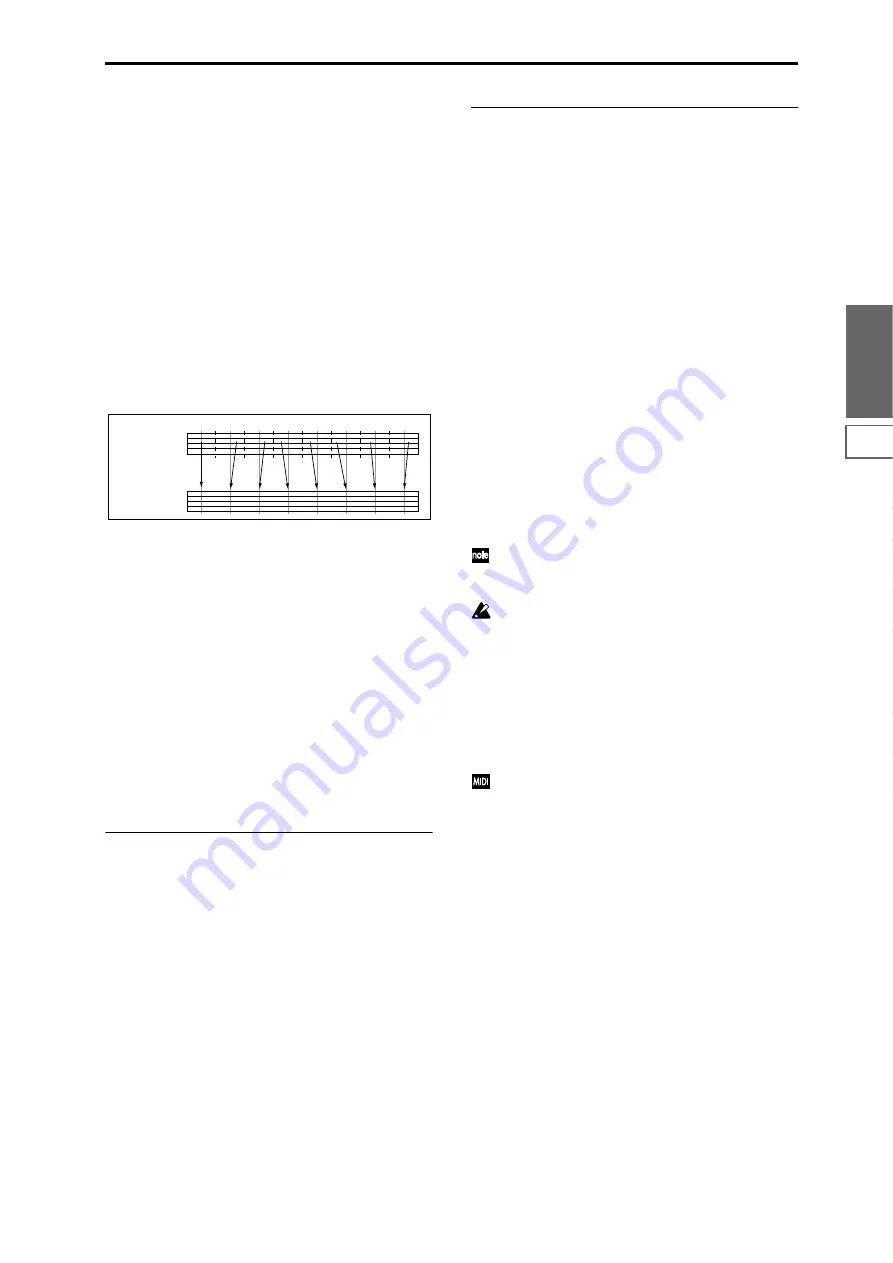
57
Sequencer
P0
P1
P2
P3
P4
P5
P6
P7
P8
P9
mitted on the MIDI channels of these tracks (whose
“Status” is EXT, EX2 or BOTH).
Master Track:
The Master Track manages overall sequencer
functions such as tempo and time signature. Select the mas-
ter track if you want to use the P5: Track Edit page menu
commands to edit the master track. You cannot perform
realtime recording or step recording on the master track by
itself.
Reso (Realtime Quantize Resolution)
[Hi,
3
…
]
This corrects the timing of data being realtime-recorded to a
MIDI track. (It does not correct previously-recorded data.)
Hi
(High Resolution): Timing will not be corrected. Data
will be recorded at the maximum resolution (
/192).
3
–
:
Data will be corrected to the nearest interval of the
specified timing as it is recorded. For example if you select
3
, data will be corrected to the nearest 32nd note triplet
interval. If you select
, data will be corrected to the nearest
quarter note interval.
Because all the MIDI data being recorded will be corrected
to the specified timing resolution, coarse settings of this
parameter will cause continuous controllers such as pitch
bend to be recorded in “stairstep” fashion.
In such cases, use a setting of Hi to record, and then use
“Quantize” (5–1N) to correct only the desired type of data
(notes etc.). It is best to avoid recording at a stiff resolution
to begin with.
RPPR On/Off
[Off, On]
This turns the RPPR (Realtime Pattern Play/Recording)
function on/off. RPPR lets you assign a pattern to each note
of the keyboard, so that the pattern will playback (or be
recorded) when you press the appropriate key.
On (checked):
The RPPR function will be on. If a pattern has
been assigned to each key in the P6: Pattern/RPPR, RPPR
Setup page, pressing that key will perform the assigned pat-
tern (
☞
P6–3: RPPR Setup).
0–1(2)b: Selected Track Information
This area displays information about the MIDI tracks (1–16).
T (Track)
(01...08 (09...16))
Indicates the track number and the program bank/number/
name specified for that track.
Ch
(01...16)
Indicates the MIDI channel number specified for the track.
RPPR
(NoAssign, C#2...C8)
This shows the key number(s) that will start the RPPR pat-
tern assigned to the track. (If there are numerous keys, not
all will be shown. To view all of the assignments, use the P6:
Pattern/RPPR, Pattern Edit page.)
0–1(2)c: Track Number, Category, Bank/Program,
PLAY/MUTE/REC, SOLO ON/OFF
Track Number
(1...8 (9...16))
Indicates the MIDI track number.
Use the parameters located below “Track Number” to make
settings for that track number.
Category
[00...15]
The program to be used by the MIDI track can be selected by
category. All programs are classified into one of sixteen cate-
gories. You can select the desired category, and then choose
programs from that category.
When you press the popup button, the Category/Track Pro-
gram Select menu will appear.(“Category/Program Select
menu”
☞
Program P0: 0–1a)
Program Select (Bank/Program)
[A...F/H...N: 0...127: name,
G/g(1)...g(9)/g(d): 1...127: name]
Selects the program that will be used by each MIDI track.
The lower line displays part of the program name.
If “Program Select” is selected, you can use the BANK [A]–
[N] keys and VALUE controller to make the setting.
If you press the popup button, the Bank/Track Program
Select menu will appear, allowing you to select a program.
(“Bank/Program Select menu”
☞
Program P0: 0–1a)
If you select “Program Select,” the BANK key LED will
light to indicate the bank of the program selected for
the track.
Bank F
can be selected if the EXB-MOSS option is
installed. When installed, 128 special EXB-MOSS pro-
grams will be available.
The program you select here will be used when the song is
played or recorded from the beginning. If the program is
changed while recording, the program change will be
recorded as musical data, and the program will change during
playback. You can also change the program manually during
playback. However if musical data (program change data) is
already recorded, the program will change at that point.
If the “Status” (2–1a/2a) is either INT or BTH, pro-
grams can be selected by receiving MIDI program
change messages. Also, when the song is changed or
when the song returns to the beginning, tracks whose
“Status” is EXT, EX2 or BTH will transmit the bank and
program numbers via MIDI. Tracks whose “Status” is
EX2
will show Bank as “–” and will transmit the bank
number that was selected in the “Bank Select” (2–1a/
2a) setting.
PLAY/MUTE/REC
[PLAY, MUTE, REC]
Here you can mute each MIDI track, and select the recording
track(s) when performing multi-track recording. During
playback, or for single-track recording (normal recording), it
is possible only to select PLAY or MUTE for tracks (play-
back tracks) other than the recording track. For multi-track
recording, tracks can be set to PLAY, MUTE, or REC. The
setting will alternate each time you press the PLAY/MUTE/
REC button
.
PLAY:
The track will play.
MUTE:
The track will be muted (silent).
REC:
This will be displayed during single-track recording
(normal recording). It cannot be selected.
When you use multi-track recording (the Preferences page
“Multi REC” is on), select REC for the tracks that you wish
to record.
With a setting of
Summary of Contents for TRITON Extreme
Page 1: ...2 E ...
Page 11: ...xii ...
Page 111: ...100 9 5 Page Menu Command 0 1A 0 1I 0 1J Program 9 5A ...
Page 185: ...174 ...
Page 215: ...204 ...
Page 281: ...270 ...
Page 349: ...338 ...
Page 350: ...339 ...
Page 351: ...340 ...
Page 352: ...341 ...
Page 353: ...342 ...















































